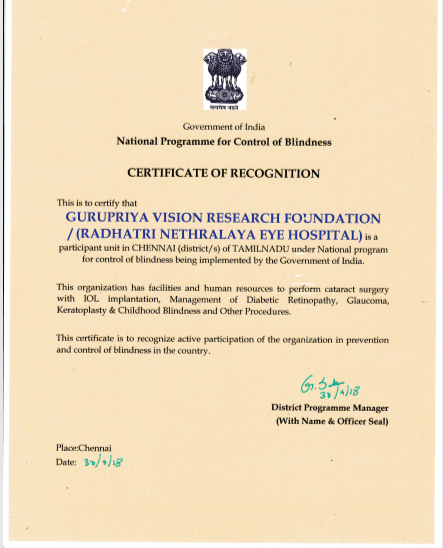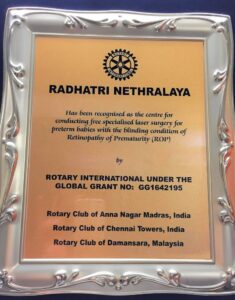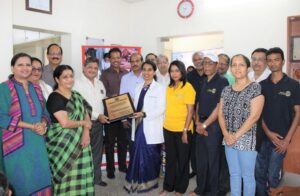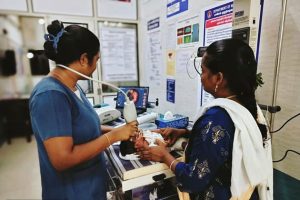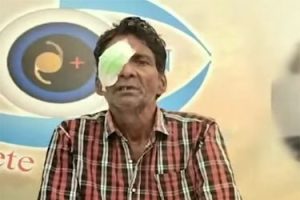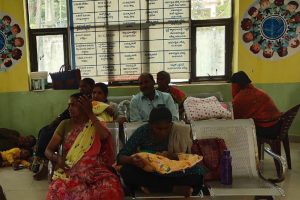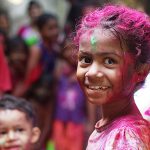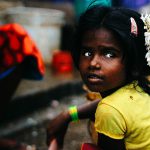
ACCREDITATION / LEGAL INFORMATION
Gurupriya Vision Research Foundation for the elimination of preventable and treatable causes of blindness.
Radhatri Nethralaya and its public charitable trust Gurupriya Vision Research Foundation, have been recognised by various organisations across the globe for their services.
Gurupriya Vision Research Foundation
Radhatri Nethralaya, a Chennai-based tertiary eye hospital, launched its charitable trust Gurupriya Vision Research Foundation (GVRF), on the occasion of its first anniversary on September 13, 2009. The trust was started with the ardent hope of eliminating the above mentioned three principal causes of needless blindness. The trust has made provisions for free screening and treatment of infants with ROP belonging to the lower strata of the society, conducts extensive school screening camps including corporation schools and spearheads awareness about diabetic retinopathy through specialty diabetic eye disease camps and awareness talks. In addition, general eye camps wherein patients with cataracts are brought in from villages and slums, operated, kept overnight and dropped back the next day are also carried out under the aegis of the trust. The trust also proposes to ensure lifelong free eye treatment for children belonging to orphanages as well as mentally challenged children.
One of the long term goals of the trust is to further combat the menace of ROP by screening the infants in hitherto unscreened rural areas in Tamil Nadu. This has been made possible with the recent procurement of the Neo Retcam, a wide-field digital portable imaging camera and using Tele-Ophthalmology to identify babies with ROP in the remote villages of Tamil Nadu. Prof. Viswanatha Raghavan, Emeritus professor from IIT, a resident of Nungambakkam, had donated the camera in July 2017 to Gurupriya Vision Research Foundation.
A van to transport the camera was also recently procured by the trust in March 2018, thanks to donations from well-wishers, which included Prof. Viswanatha Raghavan, JCI Chennai Royals, Shri. Srihari, Smt. Chitra Krishnamoorthy and Shri. Rengesh and their Families, Tamilnadu Foundation (USA) and Smt. Leela Devi Munoth Foundation. This teleophthalmology project to screen for ROP in remote places has been christened “Vision on Wheels: Balanethra Phase two”
Blindness is an unfortunate and tragic occurrence, especially if the blindness could be easily averted. There are three main causes of such needless blindness that continue to plague India today. Poverty and lack of awareness are contributing to this dismal state. The causes are:
- Retinopathy of Prematurity (ROP)
- Refractive errors in children
- Diabetic Retinopathy
Retinopathy of Prematurity (ROP)
re are certain unique problems facing a child, which is born preterm (prematurely) before the completion of the full-term of ten months. One such problem is ROP, which, if untreated or treated late, results in blindness in 50% of the cases. ROP is the most common cause of childhood blindness in the west. In India too, its prevalence is on the rise. The incidence of ROP reported in various Indian studies varies from 38% to 52%. Currently, we are facing what is called the third epidemic of ROP in the world, with developing countries such as India contributing to a major part of the disease burden. Management of ROP is a team work between committed eye specialists, sensitized pediatricians, diligent paramedical staff, efficient social workers and compliant parents. The need of the hour is the identification of the infants who are at risk and are in need of prompt treatment.
Refractive errors in children
Currently, 5% of school going children in India needs to wear glasses. Thanks to the changing life style, this percentage is on the rise. This has been our experience as well, on analysis of the data collected at the school eye screening camps conducted by us. In fact the incidence was found to be 30% in our camps! If the refractive error remains uncorrected, it affects the child vision and overall physical and mental development. Such children are also wrongly dubbed as being “dull” or “unintelligent” at school. Hence, it is of paramount importance that such children are identified and treated early. The best way to achieve this is to conduct school screening camps at the school premises itself.
Diabetic Retinopathy
Diabetes is on the rise in the country and very soon India may become the diabetic capital of the world. A diabetic patient is 25 times more likely to become blind than a non-diabetic person. Only a very small percentage of the diabetic patients are referred for an eye examination to rule out diabetic retinopathy (a sight threatening affliction caused by diabetes of the retina). Diabetic retinopathy occurs in 18% of the diabetic population, with treatable retinopathy occurring in 7% (rural) to 13% (urban) of the diabetic population. Not all ophthalmologists in India are trained to detect and treat Diabetic Retinopathy. WHO’sVISION-2020: Right to Sight Programme has clearly identified Diabetic Retinopathy as a priority area in India.
National Programme of Control of Blindness
National Programme of Control of Blindness
Radhatri Nethralaya and its public charitable trust Gurupriya Vision Research Foundation, have been recognised as partners with the National programme of control of blindness of the Government of India for elimination of preventable and treatable causes of blindness.
Gurupriya Vision Research Foundation
Radhatri Nethralaya (RN) is a 16 year-old NABH accredited super speciality tertiary eye care hospital in T. Nagar, Chennai, Tamilnadu, India. At RN, we provide international standards of best medical and surgical eye care, with compassion and sensitivity to our patient’s needs, irrespective of socio-economic background. Our Public Charitable trust, Gurupriya Vision Research Foundation (GVRF) was launched in 2009, in keeping with this philosophy to ensure free eye care to the needy.
Read MoreContact Us
Dolor sit amet consectetur adipiscing elit ut. Iaculis nunc sed augue lacus viverra.


